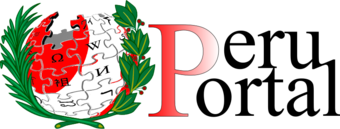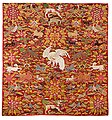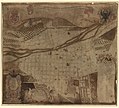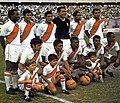Portal:Peru
Introduction
Peru, officially the Republic of Peru, is a country in western South America. It is bordered in the north by Ecuador and Colombia, in the east by Brazil, in the southeast by Bolivia, in the south by Chile, and in the south and west by the Pacific Ocean. Peru is a megadiverse country with habitats ranging from the arid plains of the Pacific coastal region in the west to the peaks of the Andes mountains extending from the north to the southeast of the country to the tropical Amazon basin rainforest in the east with the Amazon River. Peru has a population of over 32 million, and its capital and largest city is Lima. At 1,285,216 km2 (496,225 sq mi), Peru is the 19th largest country in the world, and the third largest in South America. Peruvian territory was home to several cultures during the ancient and medieval periods, and has one of the longest histories of civilization of any country, tracing its heritage back to the 10th millennium BCE. Notable pre-colonial cultures and civilizations include the Caral–Supe civilization (the earliest civilization in the Americas and considered one of the cradles of civilization), the Nazca culture, the Wari and Tiwanaku empires, the Kingdom of Cusco, and the Inca Empire, the largest known state in the pre-Columbian Americas. The Spanish Empire conquered the region in the 16th century and Charles V established a viceroyalty with the official name of the Kingdom of Peru that encompassed most of its South American territories, with its capital in Lima. Higher education started in the Americas with the official establishment of the National University of San Marcos in Lima in 1551. Peru's population includes Mestizos, Amerindians, Europeans, Africans and Asians. The main spoken language is Spanish, although a significant number of Peruvians speak Quechuan languages, Aymara, or other Indigenous languages. This mixture of cultural traditions has resulted in a wide diversity of expressions in fields such as art, cuisine, literature, and music. (Full article...) Entries here consist of Good and Featured articles, which meet a core set of high editorial standards.
The Andean condor (Vultur gryphus) is a South American New World vulture and is the only member of the genus Vultur. It is found in the Andes mountains and adjacent Pacific coasts of western South America. With a maximum wingspan of 3.3 m (10 ft 10 in) and weight of 15 kg (33 lb), the Andean condor is one of the largest flying birds in the world, and is generally considered to be the largest bird of prey in the world. It is a large black vulture with a ruff of white feathers surrounding the base of the neck and, especially in the male, large white patches on the wings. The head and neck are nearly featherless, and are a dull red color, which may flush and therefore change color in response to the bird's emotional state. In the male, there is a wattle on the neck and a large, dark red comb or caruncle on the crown of the head. The female condor is smaller than the male, an exception to the usual sexual dimorphism seen in birds of prey. (Full article...)Selected image Photo credit: Bcasterline
Amantaní is an island on the Peruvian side of Lake Titicaca. According to a 1988 census, it has a population of 3,663 Quechua speakers divided among about 800 families. The island is circular and about 9.28 km² in size. It has two mountain peaks, Pachatata (Father Earth) and Pachamama (Mother Earth), with ancient Inca and Tiwanaku ruins on top of both. The hillsides, are terraced mostly worked by hand and planted with wheat, quinoa, potatoes, and other vegetables. Livestock, including alpacas, also graze the slopes. (more...) Selected battleThe Naval Battle of Iquique was a confrontation occurred on May 21, 1879; during the naval stage of the War of the Pacific, a conflict between Chile and the alliance between Peru and Bolivia. This battle took place on the shores of the Peruvian port of Iquique, where the Peruvian ironclad Huáscar, commanded by the Captain Miguel Grau Seminario sunk the Esmeralda, an old Chilean wooden corvette led by Captain Arturo Prat Chacón; after four hours of combat. This event has become one of the most emblematic battles of this war due to the glorification of the fallen Chilean captain Prat and Peruvian Captain Miguel Grau's noble gesture of saving the enemy crew and rescuing Prat's body. (more...) In this month
General imagesThe following are images from various Peru-related articles on Wikipedia.
Selected article -While Peru accounts for about four per cent of the world's annual renewable water resources, over 98% of its water is available east of the Andes, in the Amazon region. The coastal area of Peru, with most of economic activities and more than half of the population, receives only 1.8% of the national freshwater renewable water resources. Economic and population growth are taking an increasing toll on water resources quantity and quality, especially in the coastal area of Peru. The government of Peru is currently undertaking a major transformation of its water resources management from a centralized approach focused on irrigation development in the coastal area to a river basin integrated water resources management for the entire country. The 2009 Water Resources Law (Ley de Recursos Hídricos) and the draft National Water Resources Management Strategy of 2004 (Estrategia Nacional para la Gestión de los Recursos Hídricos Continentales del Perú) contain the necessary elements for Integrated Water Resources Management as stated in international good practices namely, integration of sectoral policies, participation of stakeholders, decentralization of management to the river basin level and recognition of water as a social and economic good. Despite the new law, several key challenges remain, including limited institutional capacity, increasing water stress in the coastal region, deteriorating water quality, poor efficiency in the irrigation sector, as well as inadequate access to and poor quality of water supply and sanitation. (Full article...)Did you know (auto-generated) -
CategoriesRelated portalsSelected quote -
Peruvian writer, politician, journalist, and essayist Jorge Mario Pedro Vargas Llosa in The War of the End of the World
Basic facts & figuresMore did you know...
Peru TopicsRecognized content
Featured articlesFeatured listsGood articles
WikiProjectsThings you can do
New articlesThis list was generated from these rules. Questions and feedback are always welcome! The search is being run daily with the most recent ~14 days of results. Note: Some articles may not be relevant to this project.
Rules | Match log | Results page (for watching) | Last updated: 2024-05-27 21:47 (UTC) Note: The list display can now be customized by each user. See List display personalization for details.
Associated WikimediaThe following Wikimedia Foundation sister projects provide more on this subject:
Discover Wikipedia using portals | |||||||||||||||


















































